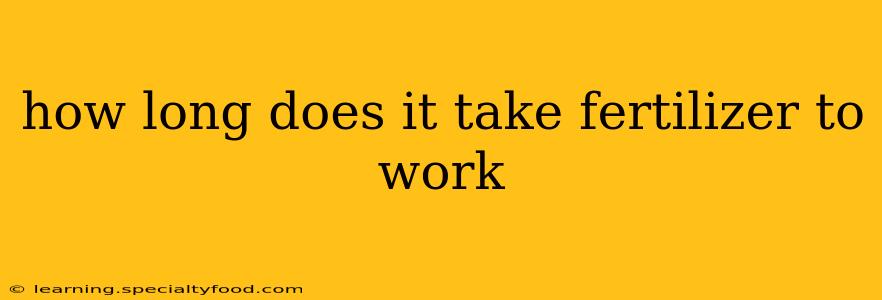Knowing how long it takes fertilizer to work is crucial for successful gardening and landscaping. The answer, however, isn't a simple number of days. The timeframe depends on several factors, making it vital to understand the process and influencing variables. This guide will break down the timeline, considering various fertilizer types and application methods.
What Type of Fertilizer Are You Using?
Different fertilizers release nutrients at varying speeds. This is often categorized as:
-
Fast-Release Fertilizers: These provide a quick burst of nutrients, ideal for plants needing immediate nourishment, such as those experiencing nutrient deficiencies or rapid growth spurts. You'll see results within days to a couple of weeks. Examples include water-soluble fertilizers and some granular options.
-
Slow-Release Fertilizers: These release nutrients gradually over weeks or even months. This sustained release prevents nutrient burn and ensures a consistent supply, reducing the frequency of applications. You might not see immediate visual results, but the overall plant health and growth will improve over a longer period (4-6 weeks or more). Osmocote and coated urea are examples of slow-release fertilizers.
-
Organic Fertilizers: Compost, manure, and other organic materials release nutrients even more slowly than slow-release fertilizers. The breakdown process is dependent on microbial activity in the soil, influenced by temperature and moisture. You'll see gradual improvements in soil health and plant growth over several months or even longer.
How Did You Apply the Fertilizer?
The application method significantly impacts the speed of nutrient uptake.
-
Topdressing: Spreading fertilizer on the soil surface allows for gradual absorption by rain or irrigation. Expect slower results compared to other methods.
-
Incorporating into the Soil: Mixing fertilizer directly into the soil allows for faster nutrient availability, as it comes into immediate contact with the roots.
-
Foliar Feeding: Applying fertilizer directly to the plant's leaves enables rapid nutrient uptake. This is usually a quick fix for deficiencies but shouldn't replace soil fertilization for long-term plant health. Results can be seen within days.
-
Watering in: Thoroughly watering in after application helps dissolve and activate the fertilizer, speeding up nutrient absorption.
What Are the Environmental Conditions?
Environmental factors heavily influence fertilizer effectiveness and the time it takes to show results:
-
Temperature: Warmer temperatures accelerate microbial activity, speeding up nutrient release from organic fertilizers and potentially speeding up uptake for all types. Cooler temperatures slow this process down.
-
Moisture: Adequate moisture is crucial for nutrient uptake. Dry soil prevents fertilizer from dissolving and reaching the plant's roots.
-
Soil Type: Different soil types have varying nutrient-holding capacities and drainage properties. Sandy soils release nutrients more quickly than clay soils, which can retain nutrients longer but sometimes make them less accessible to plants.
How Much Fertilizer Did You Use?
Over-fertilizing can harm plants, leading to nutrient burn, while under-fertilizing results in minimal or no visible effects. Following product instructions regarding application rates is crucial for optimal results.
What Are the Signs That the Fertilizer Is Working?
You'll know the fertilizer is working when you see improvements in plant health, such as:
- Increased vigor: Plants appear healthier, with stronger stems and leaves.
- Darker green leaves: This indicates better chlorophyll production, a sign of adequate nitrogen.
- More abundant blooms: Phosphorus and potassium contribute to better flowering.
- Improved fruit or vegetable production: Larger yields are a sign of successful fertilization.
Are There Any Other Factors to Consider?
Other factors, like plant species, age, and overall health, influence how quickly the plant responds to the fertilizer. A stressed or unhealthy plant may take longer to show visible improvements than a healthy plant.
In conclusion, there's no single answer to how long it takes fertilizer to work. The process is complex, depending on fertilizer type, application method, environmental conditions, and the plant itself. Observing your plants closely and adjusting your fertilization practices as needed will lead to the best results.
